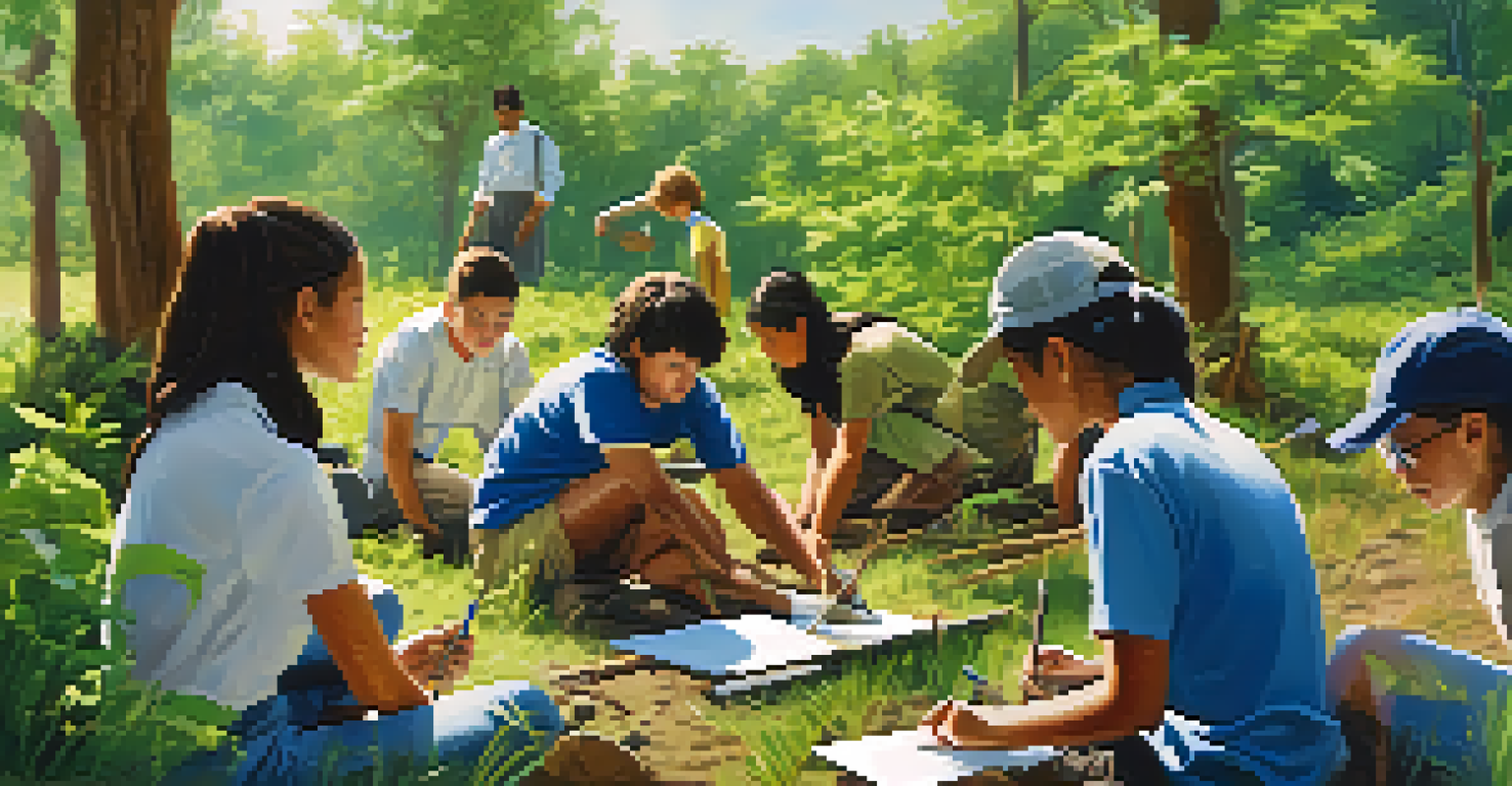Collaboration in Interdisciplinary Learning Environments

Understanding Interdisciplinary Learning Environments
Interdisciplinary learning environments bring together various fields of study, encouraging students to explore subjects through multiple lenses. This approach fosters a richer understanding of complex issues, as students learn to connect ideas from different disciplines. For example, a project on climate change might involve science, economics, and ethics, allowing students to grasp the multifaceted nature of the problem. By breaking down traditional barriers, these environments stimulate creativity and critical thinking.
Collaboration allows us to know more than we are capable of knowing by ourselves.
In today's educational landscape, the ability to collaborate across disciplines is more essential than ever. As industries evolve and challenges become increasingly complex, students must develop skills that transcend individual subjects. Interdisciplinary learning promotes teamwork and communication, preparing learners for real-world scenarios where collaboration is key. This not only enhances their academic experience but also equips them with vital skills for their future careers.
Ultimately, understanding interdisciplinary learning environments sets the stage for meaningful collaboration. Students gain confidence in working with peers from diverse backgrounds and perspectives, leading to richer discussions and innovative solutions. By embracing this approach, educational institutions can cultivate a culture of collaboration that benefits both students and educators alike.
The Role of Collaboration in Learning
Collaboration plays a pivotal role in enhancing the learning experience. When students work together, they not only share knowledge but also challenge each other's ideas, fostering deeper understanding. This dynamic exchange often leads to creative solutions that individuals might not achieve alone. For instance, a group of students tackling a design project can brainstorm unique concepts that blend their various skills and insights.

Moreover, collaboration encourages accountability among peers. When students share the responsibility of a group project, they are more likely to stay engaged and motivated. The shared goal creates a sense of community, where everyone contributes their strengths. This not only helps students develop a strong work ethic but also instills a sense of belonging that enhances their overall educational experience.
In essence, collaboration transforms traditional learning into an interactive journey. By engaging with one another, students develop critical soft skills such as teamwork, communication, and empathy. These skills are invaluable, as they prepare students for the collaborative nature of the modern workplace, paving the way for their future success.
Benefits of Interdisciplinary Collaboration
Interdisciplinary collaboration offers numerous benefits that extend beyond academic achievement. One of the most significant advantages is the ability to tackle complex problems from multiple angles. For instance, when students from different disciplines collaborate on a community health project, they can address medical, social, and economic factors, leading to more comprehensive solutions. This holistic approach enriches the learning experience and equips students with a broader perspective.
Interdisciplinary collaboration is the key to innovation and problem-solving in today's complex world.
Additionally, working with peers from diverse backgrounds fosters inclusivity and respect for different viewpoints. Students learn to appreciate the value of varying opinions and experiences, which is essential in our increasingly globalized world. This exposure not only enhances their interpersonal skills but also prepares them to navigate diverse work environments in the future.
Ultimately, the collaborative spirit nurtured in interdisciplinary learning environments cultivates innovation. By encouraging students to think outside the box and draw connections between fields, educators can spark creativity that leads to groundbreaking ideas and solutions. This not only benefits students but also contributes positively to society as a whole.
Creating a Collaborative Culture
Building a collaborative culture within interdisciplinary learning environments requires intentional effort from educators. Faculty members must model collaboration by demonstrating how to work together across disciplines. For example, co-teaching a course that integrates science and art can showcase the benefits of interdisciplinary collaboration, inspiring students to engage similarly. When educators work together, they set a powerful example for their students.
Furthermore, providing opportunities for collaboration is essential. This can include group projects, interdisciplinary workshops, and collaborative assessments that encourage students to engage with peers from other disciplines. Creating spaces where students can freely share ideas and work together fosters a sense of community and belonging. The more opportunities students have to collaborate, the more natural it becomes.
Finally, recognizing and celebrating collaborative efforts can reinforce this culture. Acknowledging students’ teamwork through awards or showcasing their projects can motivate others to follow suit. By creating an environment that values collaboration, educators can cultivate a thriving learning community that benefits everyone involved.
Challenges of Interdisciplinary Collaboration
While collaboration in interdisciplinary learning environments has numerous benefits, it also presents challenges that need to be addressed. One significant hurdle is differing communication styles among students from various disciplines. For example, a student majoring in engineering may approach a project differently than someone studying the humanities, leading to misunderstandings. Educators must facilitate discussions that help students articulate their thoughts clearly and effectively.
Another challenge is managing group dynamics. Not all students are comfortable working in teams, and some may struggle with differing levels of commitment or participation. Educators can mitigate this by establishing clear roles and expectations within groups, ensuring that everyone feels accountable. Addressing these dynamics early on can lead to healthier collaboration throughout the project.
Lastly, time constraints can be a barrier to effective collaboration. In a busy academic schedule, finding time for interdisciplinary projects can be difficult. Educators should consider integrating collaborative projects into existing curricula, allowing students to engage without overwhelming them. By being mindful of these challenges, educators can create a more supportive environment for interdisciplinary collaboration.
Strategies for Effective Collaboration
To enhance collaboration in interdisciplinary learning environments, educators can implement several effective strategies. One approach is to establish clear goals and objectives for group work. When students understand the purpose of their collaboration, they are more likely to stay focused and motivated. Setting specific milestones throughout the project can help maintain momentum and ensure that everyone is on the same page.
Another strategy is to foster a culture of open communication. Encouraging students to share their thoughts and concerns freely promotes a safe environment where everyone feels valued. Regular check-ins during group work can facilitate these conversations, allowing educators to address any issues before they escalate. This openness not only enhances collaboration but also strengthens the overall learning experience.
Lastly, incorporating technology can streamline collaboration. Tools like project management software, shared documents, and communication platforms enable students to collaborate effectively, even when they're not in the same physical space. By leveraging technology, educators can create a flexible and accessible environment that supports interdisciplinary collaboration.
The Future of Interdisciplinary Collaboration
Looking ahead, the future of interdisciplinary collaboration in learning environments is promising. As the world continues to change rapidly, the need for innovative problem-solving skills and collaborative approaches will only grow. Educational institutions that embrace interdisciplinary learning will be better equipped to prepare students for the complexities of the modern world. This proactive stance is essential for fostering a generation of thinkers and doers.
Moreover, advancements in technology are likely to enhance collaborative efforts in education. Virtual reality, augmented reality, and other emerging technologies can create immersive learning experiences that transcend traditional classroom boundaries. These tools enable students to engage with content in new ways, further enriching their collaborative projects and allowing for more dynamic interactions.

Ultimately, the future of interdisciplinary collaboration hinges on a commitment to continuous improvement. As educators seek to refine their approaches and adapt to changing needs, the focus on collaboration will remain central. By cultivating an environment that values interdisciplinary collaboration, educational institutions can empower students to become proactive problem-solvers and leaders in their fields.